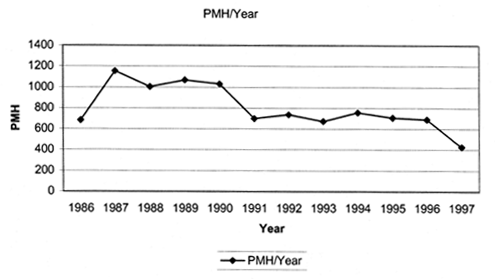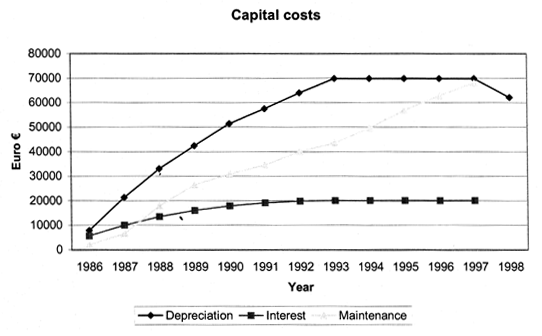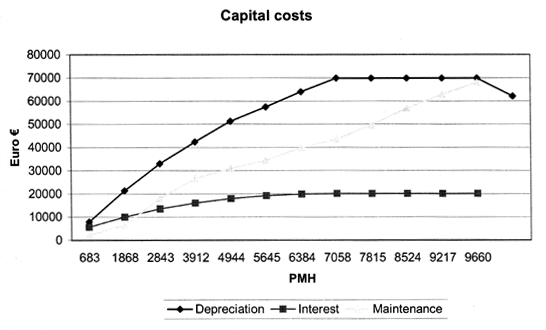Gerhard RIEGER, KWF, Gross-Umstadt, GERMANY
Summary
Machine costs are an essential part of timber harvesting costs and necessary in order to decide on different methods or machine types. This is also valid for investigations concerning performance. To compare the results with figures from other sources, the base data have to be comparable.
An important part of machine costs are capital costs (depreciation, interest) which are calculated on the basis of the estimated total time of use of the machine. Another important component of costs is costs for maintenance and repair. Over a long period the analysis of these costs can be helpful for the improvement of the technical layout of forest machines and to assist the testing work of institutions like the German Centre for Forest Work and Technology KWF.
Introduction
To assess forest operations, e.g. different harvesting methods, the following items are important:
| • costs: | - | wage costs | ||
| - | machine costs | |||
| - | overhead costs | |||
| → | costs of the whole system used (€ / PMH) | |||
| • performance: | - | usually : m3 (u.b.) solid wood | ||
| → | productivity m3 per productive machine hour (PMH) | |||
| - | additionally: parameters of influence e.g. m3/piece, logging distance and others. | |||
| → |  | |||
| • other criteria: (usually not to quantify) such as: | ||||
| - | silviculture (damages to the remaining stand) | |||
| - | ecology (damages to the soil) | |||
| - | ergonomics | |||
Some influences can be measured at every operation (e.g. direct wage costs of the crew, fuel costs of the machine, output of the operation in cubic metre or hectare), but other important factors must be calculated (e.g. capital costs per PMH or overhead costs).
Particularly in mechanized timber harvest operations, machine costs are an important issue to assess their suitability, following an example of more than ten years ago and using a small yarder.
Base for calculating machine costs
The State Forest Administration of Baden-Württemberg uses a system for machine costs following the FAO/KWF system. The costs are based on the Productive Machine Hour PMH (Grundtid G15, Maschinenarbeitsstunde).
| • depreciation: | total price(€) estimated lifetime of the machine (PMH) |
| • interest: | not yet depreciated amount × 0.08 percent |
| • fuel costs: | effective fuel and lubricant costs |
| • transport costs: | costs for machine transport from one operation site to another |
| • other costs: | partly calculated costs such as garage costs |
| partly effective costs such as insurance | |
| • maintenance costs: | maintenance and repair costs, including wages and spare parts. |
We collected the effective costs for maintenance separately for:
The total costs per year are related to the effective machine working time (PMH); the effective costs are the base for clearing costs of the next year.
The total lifetime of the machine is a good base on which to calculate the capital costs for the next generation, or for other machines still in use.
The proportion between investment costs and total maintenance cost (so-called rate of repair) is necessary to calculate machine costs before the investment is carried out.
The analysis of maintenance costs can help to improve the technical layout of new machines.
Results
The Koller K300 (trailer version) yarder for uphill hauling smaller (up to about 1 m3 per piece) timber was used for 12 years between 1986 and 1997. The system included 1 yarder, 1 tractor for stacking the timber at the roadside and 3 crewmembers.
9660 PMH (only haulage time, without installation and transport)
Ø 804 PMH per year
| Total cost: | 203.101 € | |
| Sales price: | 7.721 € | |
| Effective cost | 195.380 € |
Total cost Ø 20.23 €/PMH (without wages for operation)
| in detail: | investment | 69.803 € |
| depreciation | 7.22 €/PMH | |
| interest costs | 20.110 € | |
| Ø | 2.08 €/PMH | |
| maintenance | 67.986 € | |
| Ø | 7.04 €/PMH | |
| rate of repair | 0.97 |
| engine, gear, tower | 17 percent of total maintenance costs | |
| winders | 25 percent | = |
| ropes | 32 percent | = |
| carriage | 14 percent | = |
| other | 12 percent | = |
share of capital costs and maintenance costs on the total costs: 77 percent
Performance (productivity) about 58 000 m3
| Ø | 6.0 m3 per productive machinery hour (PMH) |
The development of operation time and cost is shown in the following figures:

Figure 1. Annual use of the K300-Yarder
Because of fluctuations in the timber market, the annual operation time decreased in 1991. The nearly full utilization at the beginning was one of the operation goals in order to reduce the investment cost not yet depreciated.

Figure 2. Addition of annual operation time
The calculated lifetime of 8 000 PMH (initially 7 000 PMH) was reached in 1994; from this date all investment capital depreciated.

Figure 3. Annual costs per PMH (depending on machine age in years and PMH)
Finishing the defined depreciation time in 1994, the costs per PMH decreased. Because of the technical layout of the machine, cost increases for maintenance were less than the decrease of capital costs.


Figure 4. Development of capital costs and maintenance costs depending on lifetime
Figure 4 shows that the chosen base for the calculation of depreciation (and interest) was too short. The technical lifetime of this machine (prerequisite: adequate maintenance) allows depreciation periods from 9 000 to 10 000 PMH.